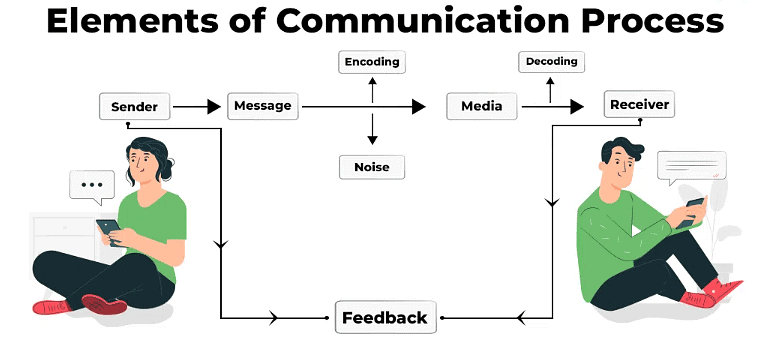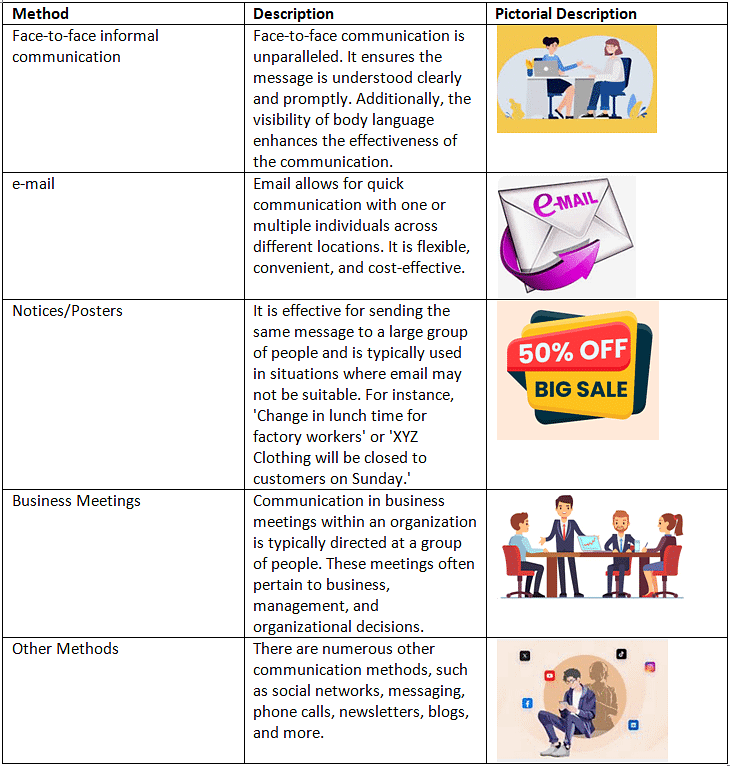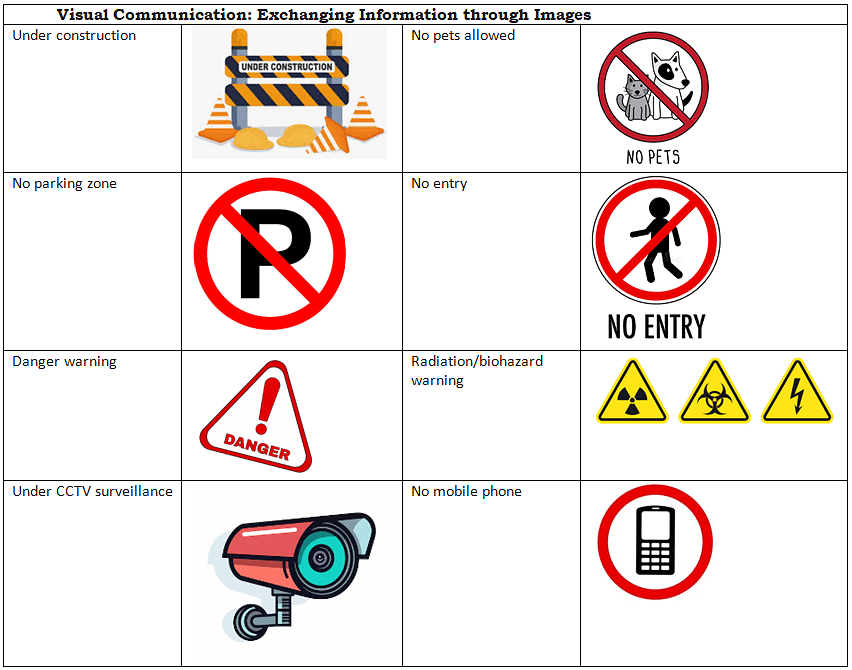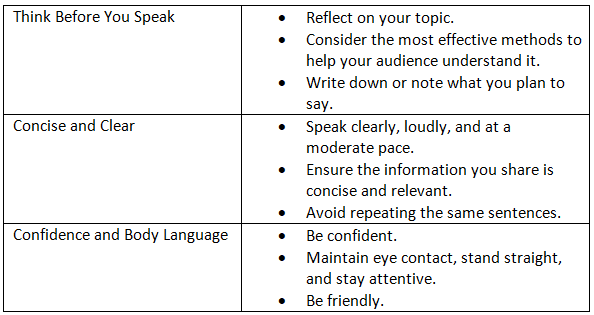Communication Skills | Artificial Intelligence for Class 10 PDF Download
| Table of contents |

|
| Introduction |

|
| Methods of Communication |

|
| Verbal Communication |

|
| Non-verbal Communication |

|
| Communication Cycle and Importance of Feedback |

|
| Barriers to Effective Communication |

|
Introduction
- In today's world, having strong language and communication skills is crucial for any job or business. As a student, it's essential to study any language thoroughly, ensuring you can read, write, speak, and listen effectively for proper communication.
- Being multilingual can enhance your ability to connect with people globally. Learning English, in addition to your native language, can help you communicate with a broader audience who also understand English.
Methods of Communication
- The term 'communication' originates from the Latin word 'communicare,' which means 'to share.' Effective communication is one of the most essential life skills, necessary for interacting successfully with people and customers. This module aims to enhance your communication abilities.
- Clear and concise communication is crucial in the workplace and business environments, where numerous parties, such as customers, employees, vendors, and the media, constantly exchange important information.
- Communication involves three key components:
- Transmitting: The sender delivers the message through a chosen medium.
- Listening: The receiver hears or comprehends the message.
- Feedback: The receiver provides their understanding of the message back to the sender, completing the communication loop.
- Consider the following example in a bookstore:
- Customer (to a retail associate): Do you have the textbook "Beauty Therapist," published by the National Council of Educational Research and Training?
- Salesperson: Let me check.
- In this exchange, the customer transmits information orally, and the salesperson is the listener. The topic of the book is the message.
- Salesperson: Yes, we have the textbook "Beauty Therapist."
- Customer: Please give me one copy of the textbook. I want to purchase it.
- In this instance, the salesperson's response serves as feedback, illustrating the communication between the customer and the salesperson. The process of conveying a message is only complete when the recipient fully understands it. Here, the customer comprehended that the bookstore has the textbook available for purchase.
Communication Process and Elements
Let's examine the communication process closely:

The communication cycle consists of several key elements:
- Sender: The individual who initiates the communication.
- Message: The information that the sender wishes to convey.
- Channel: The medium through which the information is transmitted.
- Receiver: The person to whom the message is directed.
- Feedback: The receiver’s acknowledgment and response to the message.
We constantly use various forms of communication to convey messages. Without today's diverse communication methods, conducting business as efficiently and swiftly as we do would be challenging.
Table lists some common communication methods:

Selecting the appropriate communication method depends on:
- Target audience
- Costs
- Type of information
- Urgency or priority
The communication methods you choose can impact your relationships with peers, supervisors, and customers. Therefore, it's essential to spend ample time and consider all factors to choose the right methods to assist you in your tasks.
Verbal Communication
- Verbal communication involves sounds, words, language, and speech.
- Speaking is a very effective and commonly used method of communication.
- It helps us to express our emotions using words.
- Enhancing your verbal communication abilities can help you establish a better connection and rapport with others.
Table the important types of verbal communication:


Advantages of Verbal Communication
- Verbal communication is a simple way to exchange ideas by speaking your thoughts and receiving immediate feedback.
- This form of communication allows for adjusting your conversation based on the other person's responses.
Disadvantages of Verbal Communication
- Verbal communication relies on spoken or written words, which can sometimes lead to confusion and difficulty in comprehension if the right choice of words is not made.
Mastering Verbal Communication
- Many individuals feel anxious when speaking in public or to authorities like teachers or managers.
- By focusing on the tips provided in table below, you can improve and excel in your verbal communication abilities.

Non-verbal Communication
- Non-verbal communication involves conveying information or messages without spoken or written words.
- Instead, we use expressions, gestures, postures, touch, spatial arrangements, eye contact, and paralinguistic elements to send signals and messages.
- In this the significance of various non-verbal communication skills and learn the appropriate body language for effective communication.

Importance of Non-verbal Communication
In our daily communication:
- 55% is conveyed through body movements, facial expressions, and gestures.
- 38% is conveyed through voice, tone, pauses, and other vocal elements.
- Only 7% is conveyed through spoken words.

As illustrated in Figure, approximately 93% of our communication is non-verbal. Table below provides examples of how tone of voice and body language play a role in communication.
- Our message becomes more effective when we use appropriate gestures during communication.
- Understanding non-verbal communication helps us gauge our audience's reactions and adjust our interactions accordingly.
- Employing suitable gestures and postures reflects professionalism and good etiquette.
- When verbal messages are hindered by noise or distance, hand movements can be used to convey messages. For example, placing a finger on the lips signals the need for silence, while nodding the head is equivalent to saying 'yes.'
As detailed in Table below, let's explore some of the ways we communicate non-verbally.
Types of Non-verbal Communication


Visual Communication
- Visual communication is effective because it conveys messages solely through images or pictures, eliminating the need for specific language knowledge.
- It is straightforward and remains consistent across various locations.
- Table below lists some common types of visual communication.

Communication Cycle and Importance of Feedback
- Feedback is a crucial element of the communication cycle. For communication to be effective, the sender needs to receive confirmation from the receiver that the message has been understood.
- While the sender conveys information, the receiver provides feedback on the received message. In the workplace, giving feedback involves observing someone’s performance and then communicating with them to help enhance their work. Feedback can be either positive or negative.
- Effective feedback is always:
- Specific
- Helpful
- Kind

Types of Feedback

Feedback
When shared effectively, feedback can reinforce existing strengths and help the recipient improve their abilities to address errors. It can have a lasting impact on managing and achieving goals.
Good feedback is characterized by:
- Specificity: Avoid vague comments. Provide examples to clarify your points and suggest alternatives rather than just offering advice, allowing the recipient to choose how to act on the feedback.
- Timeliness: Feedback should be given promptly, as its effectiveness diminishes if delayed for too long.
- Politeness: Ensure that feedback is delivered in a way that is respectful and not offensive.
- Ongoing Support: Feedback should be part of a continuous process. After giving feedback, let recipients know you are available to offer further support.
Importance of Feedback
Feedback is a crucial and integral part of the communication process, as it represents the response given by the receiver to the sender.
Here are some key reasons why feedback is important:
- It Validates Effective Listening: Feedback confirms that the message has been understood and shows that the feedback itself is valued.
- It Motivates: Positive feedback can encourage people to strengthen work relationships and continue performing well.
- It Is Always Present: Feedback occurs whenever you communicate with someone, making it an inevitable part of interaction.
- It Boosts Learning: Feedback helps maintain focus on goals, improve planning, and enhance products and services.
- It Improves Performance: Constructive feedback aids in making better decisions, which can enhance and increase performance.
Barriers to Effective Communication
What is Effective Communication?
- We’ve explored various communication methods: non-verbal, verbal, and visual. However, these methods are only effective when the basic principles of professional communication are followed.
- These principles can be summarized by the 7 Cs: Clear, Concise, Concrete, Correct, Coherent, Complete, and Courteous. Figure below provides further details on these principles.
- Failure to adhere to any of the 7 Cs can result in miscommunication. Let’s examine some barriers to effective communication more closely.


Barriers to Effective Communication
- Physical Barriers: Physical barriers involve environmental and natural conditions that hinder communication between sender and receiver. For instance, not being able to see gestures, posture, and body language can reduce the effectiveness of communication. Text messages, for example, often lack the richness of face-to-face interactions.
- Linguistic Barriers: Language barriers occur when individuals cannot communicate effectively due to differences in language. These are common barriers that can lead to misunderstandings and misinterpretations. Slang, professional jargon, and regional colloquialisms can complicate communication.
- Interpersonal Barriers: Interpersonal barriers arise when the message from the sender is received differently from its intended meaning. Challenges include communicating with someone unwilling to talk or share their feelings, stage fright, lack of motivation to communicate, and personal differences.
- Organisational Barriers: Organisational barriers stem from formal hierarchical structures, performance standards, rules, regulations, procedures, and policies that can impede the free flow of communication. Superior-subordinate relationships and stringent rules can also hinder communication between employees and peers.
- Cultural Barriers: Cultural barriers occur when people from different cultures struggle to understand each other’s customs, leading to misunderstandings and difficulties. Stereotypical assumptions based on cultural backgrounds can create differences in opinions and obstruct effective communication.
Ways to Overcome Barriers to Effective Communication
- Use simple language.
- Avoid making assumptions based on culture, religion, or geography.
- Communicate in person whenever possible.
- Use visuals to enhance understanding.
- Seek the assistance of a translator to bridge language differences.
- Respect others' opinions.
|
40 videos|35 docs|6 tests
|
FAQs on Communication Skills - Artificial Intelligence for Class 10
| 1. What are the different methods of communication? |  |
| 2. What is the communication cycle and why is feedback important in the process? |  |
| 3. What are some common barriers to effective communication? |  |
| 4. How can one improve their communication skills? |  |
| 5. Why is non-verbal communication important in the overall communication process? |  |

|
Explore Courses for Class 10 exam
|

|


















